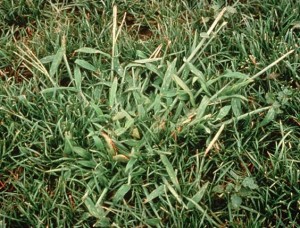What grows there? Hopefully, it’s not crabgrass this summer. Crabgrass (Digitaria spp.) is an annual weed grass that devour lawns, shrub beds and flower gardens. There are lots of effective crabgrass preventatives sold at garden shops, hardware stores, and farm supply centers.
There are numerous trademarked products. It is important to read and understand package instructions. The principal product tradenames (and active ingredients) are:
Barricade® (prodiamine)
Dimension® (dithiopyr)
Echelon® (prodiamine + sulfentrazone)
Pendulum® (pendimethalin)
Ronstar® (oxadiazon)
All products should not be used on newly seeded, sodded or sprigged lawns. In addition several store brands (not listed here) may contain the same or a different active ingredient.
Pre-emergent crabgrass control is your best option. Apply the herbicide in late winter to early spring before the crabgrass seed germinates.
Rather than choosing a calendar date as an application deadline, use forsythia, a common spring flowering shrub, for your timing guideline. If 80 % of forsythia flowers have dropped, expectations for good crabgrass control falls off if a pre-emergent preventative has not been applied.
These products provide 85% effective crabgrass control up to 100 days after application. A second application is required in late spring or early summer for a crabgrass free summer.
One additional tip is to irrigate after applying the herbicide, an equivalent of 1/2 inch of rainfall.


 Posted in
Posted in  Tags:
Tags: 
